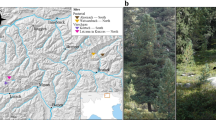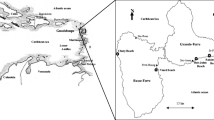Abstract
The plant intermediate wintergreen (Pyrola media, Ericaceae) is in need of conservation action in Scotland. Although widespread, it is locally distributed in dwarf shrub heath and more commonly in Scots pine (Pinus sylvestris) woodlands. A recent study on the mycorrhizal status of Pyrola suggested that they associate with a restricted range of ectomycorrhizal (ECM) fungi. Here, we examined the hypothesis that specialisation by P. media for fungi usually associated with Scots pine is a factor in promoting its occurrence in this habitat. The fungal community associated with the roots of P. media growing in a Scots pine forest was determined by morphotyping, polymerase chain reaction, cloning and sequencing. Molecular identification found 49 taxa representing ecto- and ericoid mycorrhizal fungi, dark septate endophytes, saprotrophs, and fungi of unknown trophic status. The majority of the taxa (67.4%) were Basidiomycota, with 24.4% known to be ECM fungi specific to Pinus sp. or conifers. However, a wide range of other mycorrhizal fungi with varying degrees of host specificity were also found, including taxa usually associated with deciduous hosts. In conclusion, the broad range of mycorrhizal fungi recovered from the roots of P. media suggests that specialization is not a major factor in determining its distribution.


Similar content being viewed by others
References
Abarenkov K, Nilsson RH, Larsson K-H, Alexander IJ, Eberhardt U, Erland S, Høiland K, Kjøller R, Larsson E, Pennanen T, Sen R, Taylor AFS, Ursing BM, Tedersoo, Vrålstad T, Liimatainen K, Peintner U, Kõljalg U (2010) The UNITE database for molecular identification of fungi—recent updates and future perspectives. New Phytol 186:281–285
Anonymous (2007) A five year species action framework: making a difference for Scotland’s species. The Scottish National Heritage. Available at http://www.snh.org.uk/pdfs/species/Species%20Action%20Framework. pdf. Accessed 06 May 2008
Bidartondo MI, Bruns TD (2002) Fine-level mycorrhizal specificity in the Monotropoideae (Ericaceae): specificity for fungal species groups. Mol Ecol 11:557–569
Biodiversity Action Reporting System (2010) UK priority habitats. Available at http://www.ukbap-reporting.org.uk/plans/priority.asp. Accessed 17 Feb 2010
Colwell RK (2000) EstimateS: statistical estimation of species richness and shared species from samples (software and user’s guide), version 8. Available at http://viceroy.eeb.uconn.edu/estimates
Den Bakker HC, Zuccarello GC, Kuyper TW, Noordeloos ME (2004) Evolution and host specificity in the ectomycorrhizal genus Leccinum. New Phytol 163:201–215
Grelet GA, Johnson D, Paterson E, Anderson IC, Alexander IJ (2009) Reciprocal carbon and nitrogen transfer between an ericaceous dwarf shrub and fungi isolated from Piceirhiza bicolorata ectomycorrhizas. New Phytol 182:359–366
Hall TA (1999) Bioedit: a user-friendly biological sequence alignment editor and analysis program for Windows 95/98/NT. Nucleic Acids Symposium Series 1999 41:95–98. http://www.mbio.ncsu.edu/BioEdit/bioedit.html
Hynson NA, Preiss K, Gebauer G, Bruns TD (2009) Isotopic evidence of full and partial myco-heterotrophy in the plant tribe Pyroleae (Ericaceae). New Phytol 182:719–726
Ishida TA, Nordin A (2010) No evidence that nitrogen enrichment affect fungal communities of Vaccinium roots in two contrasting boreal forest types. Soil Biol Biochem 42:234–243
Jackson PW, Kennedy K (2009) The global strategy for plant conservation: a challenge and opportunity for the international community. Trends Plant Sci 14:578–580
JNCC (2009) Conservation designations spreadsheet. Available at http://www.jncc.gov.uk/page-3408. Accessed 06 Apr 2010
Katoh K, Misawa K, Kuma K, Miyata T (2002) MAFFT: a novel method for rapid multiple sequence alignment based on fast fourier transform. Nucleic Acids Res 30:3059–3066
Knudsen H, Vesterholt J (eds) (2008) Funga nordica: Agaricoid boletoid and cyphelloid genera. Nordsvamp, Copenhagen, p 965
Massicotte HB, Melville LH, Tackaberry LE, Peterson RL (2008) A comparative study of mycorrhizas in several genera of Pyroleae (Ericaceae) from western Canada. Botany 86:610–622
McCune B, Grace JB (2002) Analysis of ecological communities. MjM Software, Lincoln
McKendrick SL, Leake JR, Taylor DL, Read DJ (2000) Symbiotic germination and development of myco-heterotrophic plants in nature: ontogeny of Corallorhiza trifida Châtel and characterisation of its mycorrhizal fungi. New Phytol 145:523–537
Peterson RL, Wagg C, Pautler M (2008) Associations between microfungal endophytes and roots: do structural features indicate function? Botany 86:445–456
Queloz V, Grünig CR, Sieber TN, Holdenrieder O (2005) Monitoring the spatial and temporal dynamics of a community of the tree-rot endophyte Phialocephala fortinii s.l. New Phytol 168:651–660
Robertson DC, Robertson JA (1985) Ultrastructional aspects of Pyrola mycorrhizae. Can J Bot 63:1089–1099
Selosse MA, Weiß M, Jany JL, Tillier A (2002) Communities and populations of sebacinoid basidiomycetes associated with the achlorophyllous orchid Neottia nidus-avis and neighbouring tree ectomycorrhizae. Mol Ecol 11:1831–1844
Sharples JM, Chambers SM, Meharg AA, Cairney JWG (2000) Genetic diversity of root-associated fungal endophytes from Calluna vulgaris at contrasting field sites. New Phytol 148:153–162
Smeins FE, Wu X (1998) Rare plants on highway rights-of-way: distribution, ecological requirements, and GIS-based predictive models. Final report. Texas Department of Transportation, Austin, p 110
Smith SE, Read DJ (2008) Mycorrhizal symbiosis, 3rd edn. Academic Press, New York, p 787
Stace CA (1997) New flora of the British Isles, 2nd edn. Cambridge University Press, Cambridge, p 1130
Taylor DL, Bruns TD, Hodges SA (2004) Evidence for mycorrhizal races in a cheating orchid. Proc Roy Soc Lond B Biol 271:35–43
Tedersoo L, Pellet P, Köljalg U (2007) Parallel evolutionary paths to mycoheterotrophy in understorey Ericaceae and Orchidaceae: ecological evidence for mixotrophy in Pyroleae. Oecologia 151:206–217
Vellak A, Tuvi EL, Reier Ü, Kalamees R, Roosaluste E, Zobel M, Pärtel M (2008) Past and present effectiveness of protected areas for conservation of naturally and anthropogenically rare plant species. Conserv Biol 23:750–757
Vincenot L, Tedersoo L, Richard F, Horcine H, Kõljalg U, Selosse MA (2008) Fungal associates of Pyrola rotundifolia, a mixotrophic Ericaceae, from two Estonian boreal forests. Mycorrhiza 19:15–25
Wiser SK, Peet RK, White PS (1998) Prediction of rare-plant occurrence: a southern Appalachian example. Ecol Appl 8:909–920
Zimmer K, Hynson NA, Gebauer G, Allen EB, Allen MF, Read DJ (2007) Wide geographical and ecological distribution of nitrogen and carbon gains from fungi in Pyroloids and monotropoids (Ericaceae) and in orchids. New Phytol 175:166–175
Acknowledgments
We wish to thank Alison Williams, Dave Sim and Joan Beaton for technical assistance, and Gwen Aëlle Grelet and Sietse van der Linde for their assistance with data analysis. The Anagach Woodland Trust kindly gave permission to use the study site. We thank The Scottish Government Rural and Environment Research and Analysis Directorate for funding.
Author information
Authors and Affiliations
Corresponding author
Electronic supplementary material
Below is the link to the electronic supplementary material.
Rights and permissions
About this article
Cite this article
Toftegaard, T., Iason, G.R., Alexander, I.J. et al. The threatened plant intermediate wintergreen (Pyrola media) associates with a wide range of biotrophic fungi in native Scottish pine woods. Biodivers Conserv 19, 3963–3971 (2010). https://doi.org/10.1007/s10531-010-9940-8
Received:
Accepted:
Published:
Issue Date:
DOI: https://doi.org/10.1007/s10531-010-9940-8




